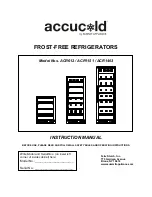
15
Ice Maker
IMPORTANT:
For models with a water filter, after connecting the
refrigerator to a water source or replacing the water filter, fill and
discard three full containers of ice to prepare the water filter for
use.
Turning the Ice Maker On/Off
To turn the ice maker on, simply lower the wire shut-off arm.
To manually turn the ice maker off, lift the wire shut-off arm to the
O
ff (arm up) position and listen for the click.
NOTE:
Your ice maker has an automatic shutoff. As ice is made,
the ice cubes will fill the ice storage bin and the ice cubes will
raise the wire shut-off arm to the O
ff
(arm up) position. Do not
force the wire shut-off arm up or down.
Ice Storage Bin
1.
Wash the ice storage bin with mild soap and warm water.
2.
Slide the ice storage bin under the ice maker and push it
toward the back as far as it will go.
3.
Lower the arm on the ice maker to the “
O
n” position.
NOTE:
It usually takes approximately 24
hours for the ice
maker to begin producing ice. You may notice the ice has
an
“off-taste.” If so, discard the first three batches of ice
produced. After that the “off-taste” should be gone.
Ice Production Rate
The ice maker should produce approximately 8 to 12 batches
of ice in a 24-hour period. Allow 3 days to completely fill the
ice container.
To increase ice production, lower the freezer and refrigerator
temperatures. See “Using the Controls.” Wait 24 hours
between adjustments.
Remember
The quality of your ice will be only as good as the quality of the
water supplied to your ice maker. Avoid connecting the ice
maker to a softened water supply. Water softener chemicals
(such as salt) can damage parts of the ice maker and lead to
poor quality ice. If a softened water supply cannot be avoided,
make sure the water softener is operating properly and is well
maintained.
Do not use anything sharp to break up the ice in the bin. This
can cause damage to the ice storage bin and the dispenser
mechanism.
Do not store anything on top of or in the ice maker or ice
storage bin.
REFRIGERATOR CARE
Cleaning
Both the refrigerator and freezer sections defrost automatically.
However, clean both sections about once a month to avoid
buildup of odors. Wipe up spills immediately.
IMPORTANT:
Because air circulates between both sections, any odors
formed in one section will transfer to the other. You must
thoroughly clean both sections to eliminate odors. To avoid
odor transfer and drying out of food, wrap or cover foods
tightly.
For stainless steel models, stainless steel is corrosion-
resistant and not corrosion-proof. To help avoid corrosion of
your stainless steel, keep your surfaces clean by using the
following cleaning instructions.
To Clean Your Refrigerator:
NOTE:
Do not use abrasive or harsh cleaners such as window
sprays, scouring cleansers, flammable fluids, muriatic acid,
cleaning waxes, concentrated detergents, bleaches
,
or cleansers
containing petroleum products on exterior surfaces (doors and
cabinet), plastic parts, interior and door liners, or gaskets. Do not
use paper towels, scouring pads, or other harsh cleaning tools.
1.
Unplug refrigerator or disconnect power.
2.
Hand wash, rinse, and dry removable parts and interior
surfaces thoroughly. Use a clean sponge or soft cloth and a
mild detergent in warm water.
3.
Clean the exterior surfaces.
Painted metal:
Wash painted metal exteriors with a clean,
soft cloth or sponge and a mild detergent in warm water.
Rinse surfaces with clean, warm water and dry immediately to
avoid water spots.
Stainless steel:
Wash stainless steel surfaces with a clean,
soft cloth or sponge and a mild detergent in warm water.
Rinse surfaces with clean, warm water and dry immediately to
avoid water spots.
NOTE:
When cleaning stainless steel, always wipe in the
direction of the grain to avoid cross-grain scratching.
4.
There is no need for routine condenser cleaning in normal
home operating environments. If the environment is
particularly greasy or dusty or there is significant pet traffic
in
the home, the condenser should be cleaned every 2 to
3
months to ensure maximum efficiency.
If you need to clean the condenser:
Remove the base grille.
Use a vacuum cleaner with a soft brush to clean the grille,
the open areas behind the grille, and the front surface area
of the condenser.
Replace the base grille when finished.
5.
Plug in refrigerator or reconnect power.
WARNING
Explosion Hazard
Use nonflammable cleaner.
Failure to do so can result in death, explosion, or fire.
















































